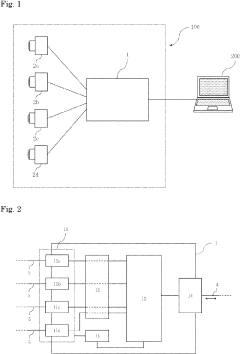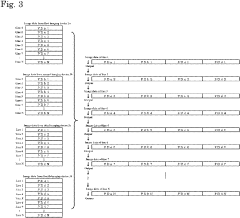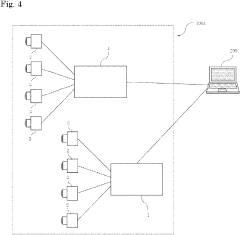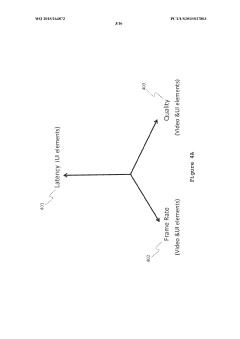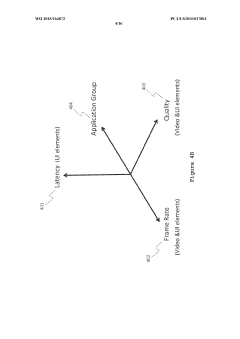How to Tailor Multiplexer Technology to Specific Applications?
JUL 13, 20259 MIN READ
Generate Your Research Report Instantly with AI Agent
Patsnap Eureka helps you evaluate technical feasibility & market potential.
Multiplexer Tech Evolution and Objectives
Multiplexer technology has evolved significantly since its inception in the mid-20th century. Initially developed for telecommunications, multiplexers have become integral components in various fields, including data communications, signal processing, and digital systems. The evolution of multiplexer technology has been driven by the increasing demand for efficient data transmission and the need to maximize the utilization of available bandwidth.
In the early stages, frequency-division multiplexing (FDM) was the primary technique used to combine multiple signals into a single transmission medium. This analog method allowed for simultaneous transmission of multiple signals over different frequency bands. As digital technology advanced, time-division multiplexing (TDM) emerged as a more efficient alternative, enabling the interleaving of digital signals in time slots.
The advent of optical fiber communications in the 1970s led to the development of wavelength-division multiplexing (WDM), which revolutionized long-distance data transmission. WDM technology allowed for multiple optical signals to be transmitted simultaneously over a single fiber, dramatically increasing bandwidth capacity.
Recent advancements in multiplexer technology have focused on improving speed, reducing power consumption, and enhancing flexibility. The introduction of dense wavelength-division multiplexing (DWDM) has further increased the capacity of optical networks, enabling the transmission of hundreds of channels over a single fiber.
The primary objective of multiplexer technology is to optimize the use of available transmission resources while maintaining signal integrity and minimizing interference. This involves developing techniques to increase the number of channels that can be multiplexed, improving signal quality, and reducing latency.
In tailoring multiplexer technology to specific applications, several key objectives must be considered. First, the technology must be adaptable to various transmission mediums, including copper wire, optical fiber, and wireless channels. Second, it should support different data rates and protocols to accommodate diverse application requirements. Third, the multiplexer design must balance performance with cost-effectiveness, power efficiency, and scalability.
Another crucial objective is to enhance the flexibility of multiplexer systems, allowing for dynamic allocation of bandwidth and easy reconfiguration to meet changing network demands. This adaptability is particularly important in modern communication networks, where traffic patterns can vary significantly over time.
As we look to the future, the evolution of multiplexer technology will likely focus on integrating advanced signal processing techniques, such as artificial intelligence and machine learning, to optimize performance and automate network management. Additionally, the development of quantum multiplexing techniques may open up new possibilities for ultra-high-capacity data transmission in the coming decades.
In the early stages, frequency-division multiplexing (FDM) was the primary technique used to combine multiple signals into a single transmission medium. This analog method allowed for simultaneous transmission of multiple signals over different frequency bands. As digital technology advanced, time-division multiplexing (TDM) emerged as a more efficient alternative, enabling the interleaving of digital signals in time slots.
The advent of optical fiber communications in the 1970s led to the development of wavelength-division multiplexing (WDM), which revolutionized long-distance data transmission. WDM technology allowed for multiple optical signals to be transmitted simultaneously over a single fiber, dramatically increasing bandwidth capacity.
Recent advancements in multiplexer technology have focused on improving speed, reducing power consumption, and enhancing flexibility. The introduction of dense wavelength-division multiplexing (DWDM) has further increased the capacity of optical networks, enabling the transmission of hundreds of channels over a single fiber.
The primary objective of multiplexer technology is to optimize the use of available transmission resources while maintaining signal integrity and minimizing interference. This involves developing techniques to increase the number of channels that can be multiplexed, improving signal quality, and reducing latency.
In tailoring multiplexer technology to specific applications, several key objectives must be considered. First, the technology must be adaptable to various transmission mediums, including copper wire, optical fiber, and wireless channels. Second, it should support different data rates and protocols to accommodate diverse application requirements. Third, the multiplexer design must balance performance with cost-effectiveness, power efficiency, and scalability.
Another crucial objective is to enhance the flexibility of multiplexer systems, allowing for dynamic allocation of bandwidth and easy reconfiguration to meet changing network demands. This adaptability is particularly important in modern communication networks, where traffic patterns can vary significantly over time.
As we look to the future, the evolution of multiplexer technology will likely focus on integrating advanced signal processing techniques, such as artificial intelligence and machine learning, to optimize performance and automate network management. Additionally, the development of quantum multiplexing techniques may open up new possibilities for ultra-high-capacity data transmission in the coming decades.
Application-Specific Market Analysis
The market for multiplexer technology is experiencing significant growth across various sectors, driven by the increasing demand for efficient data transmission and communication systems. In the telecommunications industry, multiplexers play a crucial role in optimizing bandwidth utilization and enhancing network capacity. As 5G networks continue to expand, the need for advanced multiplexing solutions is expected to surge, particularly in urban areas where network congestion is a persistent challenge.
In the automotive sector, the rise of connected and autonomous vehicles is creating new opportunities for multiplexer technology. These systems are essential for managing the complex data flows between various sensors, control units, and infotainment systems within modern vehicles. The automotive multiplexer market is projected to grow steadily as car manufacturers increasingly integrate advanced driver assistance systems (ADAS) and autonomous driving capabilities into their vehicles.
The aerospace and defense industries are also significant consumers of multiplexer technology. In aircraft and satellite communications, multiplexers are vital for ensuring reliable and secure data transmission. The increasing adoption of software-defined radio (SDR) systems in military applications is driving demand for more sophisticated multiplexing solutions that can handle multiple communication protocols and frequencies.
In the industrial automation sector, multiplexers are becoming increasingly important as factories and manufacturing facilities embrace Industry 4.0 concepts. These devices enable the integration of various sensors and control systems, facilitating real-time monitoring and data analysis for improved operational efficiency. The industrial Internet of Things (IIoT) is a key driver in this market segment, with multiplexers serving as critical components in connecting diverse industrial devices and systems.
The healthcare industry is another emerging market for specialized multiplexer applications. In medical imaging equipment, multiplexers are used to manage the complex data streams from various sensors and detectors. Additionally, in telemedicine and remote patient monitoring systems, multiplexers play a crucial role in ensuring efficient and reliable transmission of vital patient data.
As data centers continue to expand and evolve, the demand for high-performance multiplexing solutions is growing. These technologies are essential for managing the massive data flows within and between data centers, supporting cloud computing services, and enabling edge computing applications. The increasing adoption of software-defined networking (SDN) and network function virtualization (NFV) is driving innovation in multiplexer design for data center applications.
To effectively tailor multiplexer technology to these diverse applications, manufacturers must focus on developing customized solutions that address the specific requirements of each market segment. This includes considerations such as data throughput, latency, power consumption, and compatibility with existing infrastructure. Additionally, as the Internet of Things (IoT) continues to expand, there is a growing need for multiplexers that can efficiently handle the diverse data types and protocols associated with IoT devices and networks.
In the automotive sector, the rise of connected and autonomous vehicles is creating new opportunities for multiplexer technology. These systems are essential for managing the complex data flows between various sensors, control units, and infotainment systems within modern vehicles. The automotive multiplexer market is projected to grow steadily as car manufacturers increasingly integrate advanced driver assistance systems (ADAS) and autonomous driving capabilities into their vehicles.
The aerospace and defense industries are also significant consumers of multiplexer technology. In aircraft and satellite communications, multiplexers are vital for ensuring reliable and secure data transmission. The increasing adoption of software-defined radio (SDR) systems in military applications is driving demand for more sophisticated multiplexing solutions that can handle multiple communication protocols and frequencies.
In the industrial automation sector, multiplexers are becoming increasingly important as factories and manufacturing facilities embrace Industry 4.0 concepts. These devices enable the integration of various sensors and control systems, facilitating real-time monitoring and data analysis for improved operational efficiency. The industrial Internet of Things (IIoT) is a key driver in this market segment, with multiplexers serving as critical components in connecting diverse industrial devices and systems.
The healthcare industry is another emerging market for specialized multiplexer applications. In medical imaging equipment, multiplexers are used to manage the complex data streams from various sensors and detectors. Additionally, in telemedicine and remote patient monitoring systems, multiplexers play a crucial role in ensuring efficient and reliable transmission of vital patient data.
As data centers continue to expand and evolve, the demand for high-performance multiplexing solutions is growing. These technologies are essential for managing the massive data flows within and between data centers, supporting cloud computing services, and enabling edge computing applications. The increasing adoption of software-defined networking (SDN) and network function virtualization (NFV) is driving innovation in multiplexer design for data center applications.
To effectively tailor multiplexer technology to these diverse applications, manufacturers must focus on developing customized solutions that address the specific requirements of each market segment. This includes considerations such as data throughput, latency, power consumption, and compatibility with existing infrastructure. Additionally, as the Internet of Things (IoT) continues to expand, there is a growing need for multiplexers that can efficiently handle the diverse data types and protocols associated with IoT devices and networks.
Current Multiplexer Limitations
Despite the widespread adoption of multiplexer technology across various industries, current implementations face several limitations that hinder their optimal performance in specific applications. One of the primary constraints is the trade-off between channel capacity and signal quality. As the number of multiplexed channels increases, the overall signal-to-noise ratio tends to decrease, leading to potential data loss or degradation in transmission fidelity.
Another significant limitation is the bandwidth bottleneck. While multiplexers can efficiently combine multiple signals into a single transmission medium, they are ultimately constrained by the available bandwidth of that medium. This limitation becomes particularly apparent in high-data-rate applications, where the demand for increased throughput often outpaces the capabilities of existing multiplexer systems.
Latency issues also pose a challenge in time-sensitive applications. The process of multiplexing and demultiplexing introduces inherent delays, which can be problematic in real-time systems or applications requiring ultra-low latency, such as financial trading platforms or autonomous vehicle control systems.
Compatibility across different protocols and standards remains a persistent hurdle. As multiplexer technology evolves, ensuring seamless integration with legacy systems and emerging communication protocols becomes increasingly complex. This lack of universal compatibility can lead to interoperability issues and increased implementation costs.
Power consumption is another area of concern, especially in portable or battery-operated devices. Current multiplexer designs often struggle to balance performance with energy efficiency, limiting their applicability in power-constrained environments such as IoT devices or remote sensing applications.
Scalability presents a further challenge, particularly in rapidly growing networks. As the number of channels or data streams increases, traditional multiplexing architectures may struggle to accommodate the expanding demand without significant redesign or infrastructure upgrades.
Lastly, the complexity of multiplexer configuration and management can be a limiting factor in dynamic environments. Many current systems lack the flexibility to adapt quickly to changing network conditions or application requirements, necessitating manual intervention and potentially causing service disruptions.
Addressing these limitations is crucial for tailoring multiplexer technology to specific applications effectively. Future developments in this field will need to focus on innovative solutions that can overcome these constraints while meeting the unique demands of diverse industry sectors.
Another significant limitation is the bandwidth bottleneck. While multiplexers can efficiently combine multiple signals into a single transmission medium, they are ultimately constrained by the available bandwidth of that medium. This limitation becomes particularly apparent in high-data-rate applications, where the demand for increased throughput often outpaces the capabilities of existing multiplexer systems.
Latency issues also pose a challenge in time-sensitive applications. The process of multiplexing and demultiplexing introduces inherent delays, which can be problematic in real-time systems or applications requiring ultra-low latency, such as financial trading platforms or autonomous vehicle control systems.
Compatibility across different protocols and standards remains a persistent hurdle. As multiplexer technology evolves, ensuring seamless integration with legacy systems and emerging communication protocols becomes increasingly complex. This lack of universal compatibility can lead to interoperability issues and increased implementation costs.
Power consumption is another area of concern, especially in portable or battery-operated devices. Current multiplexer designs often struggle to balance performance with energy efficiency, limiting their applicability in power-constrained environments such as IoT devices or remote sensing applications.
Scalability presents a further challenge, particularly in rapidly growing networks. As the number of channels or data streams increases, traditional multiplexing architectures may struggle to accommodate the expanding demand without significant redesign or infrastructure upgrades.
Lastly, the complexity of multiplexer configuration and management can be a limiting factor in dynamic environments. Many current systems lack the flexibility to adapt quickly to changing network conditions or application requirements, necessitating manual intervention and potentially causing service disruptions.
Addressing these limitations is crucial for tailoring multiplexer technology to specific applications effectively. Future developments in this field will need to focus on innovative solutions that can overcome these constraints while meeting the unique demands of diverse industry sectors.
Tailoring Strategies for Applications
01 Optical multiplexing technologies
Optical multiplexing technologies are used in fiber optic communication systems to combine multiple signals onto a single optical fiber. These technologies include wavelength division multiplexing (WDM) and time division multiplexing (TDM), which allow for increased data transmission capacity and efficient use of network resources.- Optical multiplexing technologies: Optical multiplexing technologies are used in fiber optic communication systems to combine multiple signals onto a single optical fiber. These technologies include wavelength division multiplexing (WDM) and time division multiplexing (TDM), which allow for increased data transmission capacity and efficient use of optical network resources.
- Digital multiplexing in communication systems: Digital multiplexing techniques are employed in various communication systems to combine multiple digital signals into a single transmission stream. These methods include time division multiplexing (TDM) and frequency division multiplexing (FDM), which enable efficient use of bandwidth and support multiple users or channels on a shared medium.
- Multiplexer circuit design and implementation: Multiplexer circuit design focuses on creating efficient and high-performance switching devices that select one of several input signals and forward it to a single output. These designs incorporate various techniques to optimize speed, power consumption, and signal integrity in applications ranging from digital logic to analog signal processing.
- Multiplexing in wireless communication systems: Multiplexing techniques are crucial in wireless communication systems for efficient spectrum utilization and supporting multiple users. These include orthogonal frequency-division multiplexing (OFDM), code division multiple access (CDMA), and spatial multiplexing in MIMO systems, which enable high data rates and improved system capacity.
- Multiplexer applications in sensor and imaging systems: Multiplexers play a vital role in sensor and imaging systems by enabling the selection and processing of multiple input signals from various sensors or detector elements. These applications include infrared imaging, medical imaging, and environmental monitoring, where multiplexers help in efficient data acquisition and processing.
02 Digital multiplexing in communication systems
Digital multiplexing techniques are employed in various communication systems to combine multiple digital signals into a single transmission stream. These methods include time division multiplexing (TDM) and frequency division multiplexing (FDM), which enable efficient use of bandwidth and support multiple users or channels on a shared medium.Expand Specific Solutions03 Multiplexer circuit design and implementation
Multiplexer circuit design focuses on creating efficient and high-performance switching devices that select one of several input signals and forward it to a single output. These circuits are fundamental components in digital systems and can be implemented using various technologies, including CMOS and pass transistor logic.Expand Specific Solutions04 Multiplexing in wireless communication systems
Multiplexing techniques are crucial in wireless communication systems for efficient spectrum utilization and supporting multiple users. These include frequency division multiple access (FDMA), time division multiple access (TDMA), and code division multiple access (CDMA), which allow multiple users to share the same frequency band simultaneously.Expand Specific Solutions05 Multiplexer applications in sensor networks and IoT
Multiplexers play a significant role in sensor networks and Internet of Things (IoT) applications by enabling the efficient collection and transmission of data from multiple sensors. These devices help reduce the number of communication channels required and optimize power consumption in resource-constrained environments.Expand Specific Solutions
Key Multiplexer Manufacturers
The multiplexer technology market is in a mature growth phase, with a substantial global market size driven by increasing demand for high-speed data transmission and network capacity expansion. The technology's maturity is evident in its widespread adoption across various applications, from telecommunications to data centers. Key players like Huawei, Ericsson, and NEC are at the forefront, leveraging their extensive R&D capabilities to tailor multiplexer solutions for specific use cases. Companies such as Ciena and Fujitsu are focusing on innovative approaches to address emerging challenges in 5G networks and cloud computing. The competitive landscape is characterized by a mix of established telecom giants and specialized optical networking firms, with ongoing efforts to enhance multiplexer efficiency and adaptability for diverse industry requirements.
Telefonaktiebolaget LM Ericsson
Technical Solution: Ericsson has developed a dynamic spectrum sharing (DSS) technology that allows for simultaneous operation of 4G and 5G in the same frequency band. This multiplexing solution enables operators to efficiently allocate spectrum resources between different radio access technologies[2]. Ericsson's multiplexers utilize advanced signal processing techniques and machine learning algorithms to optimize spectrum usage in real-time, adapting to changing network conditions and user demands[4]. The company has also introduced Time-Division Duplex (TDD) multiplexing solutions for 5G, which allow for flexible uplink and downlink capacity allocation, improving overall network efficiency[6].
Strengths: Seamless integration of 4G and 5G technologies, adaptive spectrum allocation, and flexible capacity management. Weaknesses: Complexity in implementation and potential interoperability issues with legacy systems.
NEC Corp.
Technical Solution: NEC has developed multiplexer technologies tailored for both wireless and optical networks. In the wireless domain, NEC's massive MIMO solutions incorporate advanced spatial multiplexing techniques to enhance capacity and coverage in 5G networks[13]. For optical networks, NEC has introduced programmable optical add/drop multiplexers (ROADMs) that enable flexible wavelength routing and dynamic spectrum allocation[15]. The company has also implemented AI-driven multiplexing solutions that optimize network resource utilization and predict traffic patterns for proactive capacity management[17].
Strengths: Comprehensive portfolio covering both wireless and optical domains, AI-driven optimization, and flexible network architecture. Weaknesses: Strong competition in key markets and potential challenges in maintaining technological edge across diverse product lines.
Innovative Multiplexer Architectures
Multiplexer and imaging system
PatentPendingUS20230370186A1
Innovation
- A multiplexer that converts image data from multiple cameras following the CoaXPress standard to the GigE Vision standard, utilizing an input unit, processing unit, and storage unit to buffer and synchronize data, allowing for simultaneous transmission without the need for individual conversion units and maintaining data synchronicity.
Intelligent multiplexing using class-based, multi-dimensioned decision logic for managed networks
PatentWO2015164872A1
Innovation
- The implementation of class-based, multi-dimensional decision logic for bandwidth allocation, prioritizing transport control information, audio, video, and graphical user interface elements, allows for dynamic adjustment of bandwidth allocation per frame time, deferring or dropping less critical data to maintain smooth and uninterrupted service.
Performance Metrics and Testing
Performance metrics and testing are crucial aspects of tailoring multiplexer technology to specific applications. The selection and optimization of appropriate metrics ensure that the multiplexer meets the requirements of the intended use case. Key performance indicators typically include insertion loss, return loss, isolation, crosstalk, and bandwidth.
Insertion loss measures the signal power loss as it passes through the multiplexer. Lower insertion loss is generally desirable, as it indicates better signal transmission efficiency. Return loss quantifies the amount of signal reflected back to the source, with higher values indicating better impedance matching and less signal reflection. Isolation refers to the degree of separation between different channels or ports, crucial for preventing signal interference. Crosstalk, closely related to isolation, measures the undesired coupling between channels. Minimizing crosstalk is essential for maintaining signal integrity in multi-channel applications.
Bandwidth is a critical metric that determines the range of frequencies over which the multiplexer can effectively operate. Depending on the specific application, wide bandwidth or precise frequency selectivity may be prioritized. Additional metrics such as power handling capacity, linearity, and temperature stability may also be considered based on the application requirements.
Testing procedures for multiplexers typically involve network analysis using vector network analyzers (VNAs) to measure S-parameters. These measurements provide comprehensive data on insertion loss, return loss, isolation, and other frequency-dependent characteristics. Time-domain reflectometry (TDR) may be employed to analyze signal integrity and identify impedance mismatches or discontinuities in the multiplexer structure.
Environmental testing is often necessary to ensure the multiplexer's performance under various operating conditions. This may include temperature cycling, humidity exposure, and vibration testing. For high-reliability applications such as aerospace or military use, additional tests like shock resistance and radiation hardness may be required.
Intermodulation distortion (IMD) testing is crucial for applications involving multiple input signals, as it assesses the multiplexer's linearity and its ability to handle complex signal environments without generating spurious products. Power handling tests evaluate the device's ability to operate at high signal levels without degradation or failure.
Customized testing protocols may be developed for specific applications. For instance, in optical multiplexing, bit error rate (BER) testing and eye diagram analysis are commonly used to assess signal quality and system performance. In radio frequency (RF) applications, noise figure measurements and phase noise testing may be incorporated to evaluate the multiplexer's impact on overall system sensitivity and signal purity.
Insertion loss measures the signal power loss as it passes through the multiplexer. Lower insertion loss is generally desirable, as it indicates better signal transmission efficiency. Return loss quantifies the amount of signal reflected back to the source, with higher values indicating better impedance matching and less signal reflection. Isolation refers to the degree of separation between different channels or ports, crucial for preventing signal interference. Crosstalk, closely related to isolation, measures the undesired coupling between channels. Minimizing crosstalk is essential for maintaining signal integrity in multi-channel applications.
Bandwidth is a critical metric that determines the range of frequencies over which the multiplexer can effectively operate. Depending on the specific application, wide bandwidth or precise frequency selectivity may be prioritized. Additional metrics such as power handling capacity, linearity, and temperature stability may also be considered based on the application requirements.
Testing procedures for multiplexers typically involve network analysis using vector network analyzers (VNAs) to measure S-parameters. These measurements provide comprehensive data on insertion loss, return loss, isolation, and other frequency-dependent characteristics. Time-domain reflectometry (TDR) may be employed to analyze signal integrity and identify impedance mismatches or discontinuities in the multiplexer structure.
Environmental testing is often necessary to ensure the multiplexer's performance under various operating conditions. This may include temperature cycling, humidity exposure, and vibration testing. For high-reliability applications such as aerospace or military use, additional tests like shock resistance and radiation hardness may be required.
Intermodulation distortion (IMD) testing is crucial for applications involving multiple input signals, as it assesses the multiplexer's linearity and its ability to handle complex signal environments without generating spurious products. Power handling tests evaluate the device's ability to operate at high signal levels without degradation or failure.
Customized testing protocols may be developed for specific applications. For instance, in optical multiplexing, bit error rate (BER) testing and eye diagram analysis are commonly used to assess signal quality and system performance. In radio frequency (RF) applications, noise figure measurements and phase noise testing may be incorporated to evaluate the multiplexer's impact on overall system sensitivity and signal purity.
Scalability and Integration Challenges
As multiplexer technology continues to evolve and find applications in diverse fields, scalability and integration challenges have become increasingly prominent. These challenges stem from the need to adapt multiplexer systems to handle growing data volumes, diverse signal types, and complex network architectures across various industries.
One of the primary scalability challenges lies in expanding the capacity of multiplexers to accommodate higher data rates and larger numbers of input channels. As applications demand greater bandwidth and more sophisticated signal processing, multiplexer designs must evolve to support these requirements without compromising performance or introducing excessive latency. This often involves developing new switching architectures, implementing advanced signal processing algorithms, and optimizing power consumption to maintain efficiency at scale.
Integration challenges arise when incorporating multiplexer technology into existing systems or combining it with other emerging technologies. Compatibility issues may occur when interfacing multiplexers with legacy equipment or adapting them to work with different communication protocols. Additionally, as multiplexers are integrated into more compact and portable devices, designers must address space constraints and thermal management concerns while maintaining signal integrity and minimizing electromagnetic interference.
The increasing complexity of multiplexed systems also presents challenges in terms of control and management. As the number of channels and signal types grows, so does the need for sophisticated control mechanisms and intelligent routing algorithms. This necessitates the development of advanced software-defined networking (SDN) approaches and automated configuration tools to efficiently manage large-scale multiplexer deployments.
Another significant challenge is ensuring the reliability and fault tolerance of multiplexer systems as they scale up. Redundancy mechanisms, error detection and correction techniques, and robust failover strategies must be implemented to maintain uninterrupted operation in critical applications. This becomes particularly crucial in sectors such as telecommunications, aerospace, and industrial automation, where system downtime can have severe consequences.
Addressing these scalability and integration challenges requires a multidisciplinary approach, combining innovations in hardware design, signal processing algorithms, control software, and system architecture. As multiplexer technology continues to advance, overcoming these hurdles will be essential to unlocking its full potential across a wide range of applications and industries.
One of the primary scalability challenges lies in expanding the capacity of multiplexers to accommodate higher data rates and larger numbers of input channels. As applications demand greater bandwidth and more sophisticated signal processing, multiplexer designs must evolve to support these requirements without compromising performance or introducing excessive latency. This often involves developing new switching architectures, implementing advanced signal processing algorithms, and optimizing power consumption to maintain efficiency at scale.
Integration challenges arise when incorporating multiplexer technology into existing systems or combining it with other emerging technologies. Compatibility issues may occur when interfacing multiplexers with legacy equipment or adapting them to work with different communication protocols. Additionally, as multiplexers are integrated into more compact and portable devices, designers must address space constraints and thermal management concerns while maintaining signal integrity and minimizing electromagnetic interference.
The increasing complexity of multiplexed systems also presents challenges in terms of control and management. As the number of channels and signal types grows, so does the need for sophisticated control mechanisms and intelligent routing algorithms. This necessitates the development of advanced software-defined networking (SDN) approaches and automated configuration tools to efficiently manage large-scale multiplexer deployments.
Another significant challenge is ensuring the reliability and fault tolerance of multiplexer systems as they scale up. Redundancy mechanisms, error detection and correction techniques, and robust failover strategies must be implemented to maintain uninterrupted operation in critical applications. This becomes particularly crucial in sectors such as telecommunications, aerospace, and industrial automation, where system downtime can have severe consequences.
Addressing these scalability and integration challenges requires a multidisciplinary approach, combining innovations in hardware design, signal processing algorithms, control software, and system architecture. As multiplexer technology continues to advance, overcoming these hurdles will be essential to unlocking its full potential across a wide range of applications and industries.
Unlock deeper insights with Patsnap Eureka Quick Research — get a full tech report to explore trends and direct your research. Try now!
Generate Your Research Report Instantly with AI Agent
Supercharge your innovation with Patsnap Eureka AI Agent Platform!
